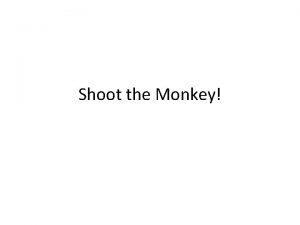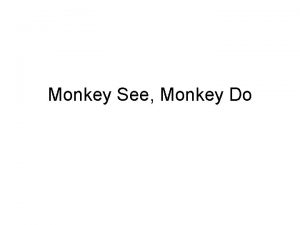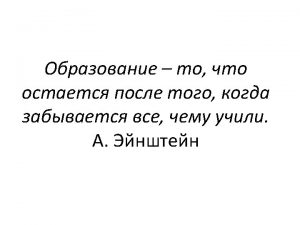THE MONKEY AND THE ZOOKEPER A monkey spends























- Slides: 23

THE MONKEY AND THE ZOOKEPER A monkey spends most of its day hanging from a branch of a tree waiting to be fed by the zookeeper. The zookeeper shoots bananas from a banana cannon. Unfortunately, the monkey drops from the tree the moment that the banana leaves the muzzle of the cannon and the zookeeper is faced with the dilemma of where to aim the banana cannon in order to feed the monkey. If the monkey lets go of the tree the moment that the banana is fired, where should he aim the banana cannon? Wilson/Buffa, COLLEGE PHYSICS, Media Portfolio, 5/e, © 2003. Electronically reproduced by permission of Pearson Education, Inc. , Upper Saddle River, New Jersey.

If the zookeeper aims above the monkey what would be the path of the banana? Would the banana hit the monkey? Let’s find out! Banana thrown ABOVE the monkey http: //www. physicsclassroom. com/mmedia/vectors/mzg. html Wrong move!

If the zookeeper aims directly at the monkey what would be the path of the banana? Would the banana hit the monkey? Let’s find out! Banana thrown AT the monkey http: //www. physicsclassroom. com/mmedia/vectors/mzf. html What will happen if the banana is thrown at a lower speed? Banana thrown slowly at the monkey http: //www. physicsclassroom. com/mmedia/vectors/mzs. html Happy monkey!

Monkey and Balloon In this simulation the cannon is always aimed directly at the monkey which is hanging from a branch. When you fire the banana towards the monkey, it lets go of the branch at the same instant. Can you ever miss the monkey? Why?

PROJECTILE MOTION An object launched into space without motive power of its own is called a projectile. If we neglect air resistance, the only force acting on a projectile is its weight, which causes its path to deviate from a straight line. The projectile has a constant horizontal velocity and a vertical velocity that changes uniformly under the influence of the acceleration due to gravity.

HORIZONTAL PROJECTION If an object is projected horizontally, its motion can best be described by considering its horizontal and vertical motion separately. In the figure we can see that the vertical velocity and position increase with time as those of a free-falling body. Note that the horizontal distance increases linearly with time, indicating a constant horizontal velocity.

Instantaneous Velocity Note the direction of instantaneous velocity is tangent to the path of the projectile

3. 1 An airplane traveling at 80 m/s at an elevation of 250 m drops a box of supplies to skiers stranded in a snowstorm. a. At what horizontal distance from the skiers should the supplies be dropped? vo = 80 m/s y = 250 m y = voyt + ½ gt 2 =7 s x = voxt = 80(7) = 560 m

b. Find the magnitude of the velocity of the box as it reaches the ground. vx = vox = 80 m/s and vy = voy + gt = 9. 8 (7) = 68. 6 m/s = 105. 4 m/s

3. 2 A person standing on a cliff throws a stone with a horizontal velocity of 15. 0 m/s and the stone hits the ground 47. 0 m from the base of the cliff. How high is the cliff? vo = 15. 0 m/s x = 47. 0 m vy = 0 = 3. 13 s y = voy t +½ gt 2 = 0 + ½ (9. 8)(3. 13)2 = 48 m

PROJECTILE MOTION AT AN ANGLE The more general case of projectile motion occurs when the projectile is fired at an angle.

Problem Solution Strategy: 1. Upward direction is positive. Acceleration due to gravity (g) is downward thus g = - 9. 8 m/s 2 2. Resolve the initial velocity vo into its x and y components: vox = vo cos θ voy = vo sin θ 3. The horizontal and vertical components of its position at any instant is given by: x = voxt y = voy t +½gt 2 4. The horizontal and vertical components of its velocity at any instant are given by: vx = vox vy = voy + gt 5. The final position and velocity can then be obtained from their components.

3. 3 An artillery shell is fired with an initial velocity of 100 m/s at an angle of 30 above the horizontal. Find: a. Its position and velocity after 8 s vo = 100 m/s, 30 t=8 s g = - 9. 8 m/s 2 x = vox t = 86. 6(8) = 692. 8 m y = voy t + ½ gt 2 = 50(8) + ½ (-9. 8)(8)2 = 86. 4 m vox = 100 cos 30 = 86. 6 m/s voy = 100 sin 30 = 50 m/s vx = vox = 86. 6 m/s vy = voy + gt = 50 + (-9. 8)(8) = - 28. 4 m/s

b. The time required to reach its maximum height At the top of the path: vy = 0 vy = voy + gt = 5. 1 s c. The horizontal distance (range) Total time T = 2 t = 2(5. 1) = 10. 2 s x = vox t = 86. 6(10. 2) = 883. 7 m

3. 4 A plastic ball that is released with a velocity of 15 m/s stays in the air for 2. 0 s. a. At what angle with respect to the horizontal was it released? vo = 15 m/s t=2 s time to maximum height = 1 s at the top vy = 0 vy = voy + gt = 40. 8º

b. What was the maximum height achieved by the ball? y = voy t +½gt 2 = (15)(sin 40. 8º)(1) + ½(-9. 8)(1)2 = 4. 9 m

3. 5 An arrow was shot at an angle of 55º with respect to the horizontal. The arrow landed at a horizontal distance of 875 m. Find the velocity of the arrow at the top of its path. θ = 55º x = 875 m total time of flight: y = voy t +½gt 2 if y = 0 0 = t (voy + ½ gt) voy = ½ gt vo sin θ =½ g t

substituting the time and solving for vo = 95. 5 m/s At the top of its path the arrow has vy = o and vx = vox = 95. 5 cos 55º = 54. 8 m/s

3. 6 Find the range of a gun which fires a shell with muzzle velocity vo at an angle θ. What is the maximum range possible? At top vy = 0 vy = voy + gt = vo sin θ - gt Total time = 2 t x = v xt

sin θ cos θ= ½ sin 2θ Maximum range is 45 since 2θ = 90

b. Find the angle of elevation of a gun that fires a shell with muzzle velocity of 125 m/s and hits a target on the same level but 1. 55 km distant. vo = 125 m/s x = 1. 55 km = 0. 9721 sin-1(2θ) =76. 4 θ = 38. 2º


 Monkey see monkey do monkey connect
Monkey see monkey do monkey connect Opposable thumb primates
Opposable thumb primates Brave monkey scared monkey
Brave monkey scared monkey Abracadabra family kinetic letters
Abracadabra family kinetic letters Trevor spends 45 minutes a day in front of an intense light
Trevor spends 45 minutes a day in front of an intense light One who spends very little
One who spends very little Monkey's paw pictures
Monkey's paw pictures The monkey s paw characters
The monkey s paw characters Hình ảnh bộ gõ cơ thể búng tay
Hình ảnh bộ gõ cơ thể búng tay Frameset trong html5
Frameset trong html5 Bổ thể
Bổ thể Tỉ lệ cơ thể trẻ em
Tỉ lệ cơ thể trẻ em Gấu đi như thế nào
Gấu đi như thế nào Tư thế worms-breton
Tư thế worms-breton Chúa yêu trần thế alleluia
Chúa yêu trần thế alleluia Môn thể thao bắt đầu bằng chữ đua
Môn thể thao bắt đầu bằng chữ đua Thế nào là hệ số cao nhất
Thế nào là hệ số cao nhất Các châu lục và đại dương trên thế giới
Các châu lục và đại dương trên thế giới Công thức tính độ biến thiên đông lượng
Công thức tính độ biến thiên đông lượng Trời xanh đây là của chúng ta thể thơ
Trời xanh đây là của chúng ta thể thơ Mật thư tọa độ 5x5
Mật thư tọa độ 5x5 101012 bằng
101012 bằng độ dài liên kết
độ dài liên kết Các châu lục và đại dương trên thế giới
Các châu lục và đại dương trên thế giới













































